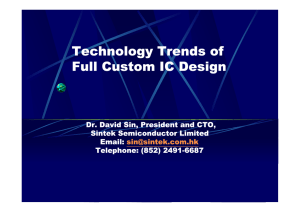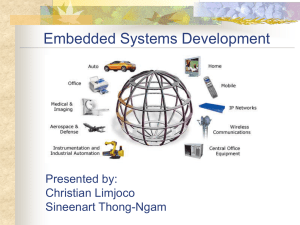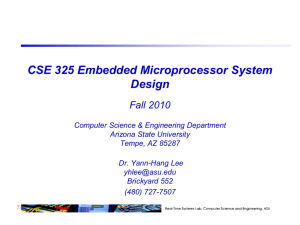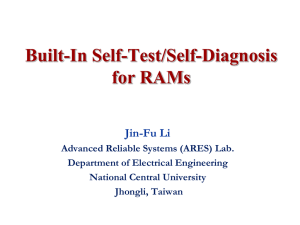Challenges In Embedded Memory Design And Test
advertisement
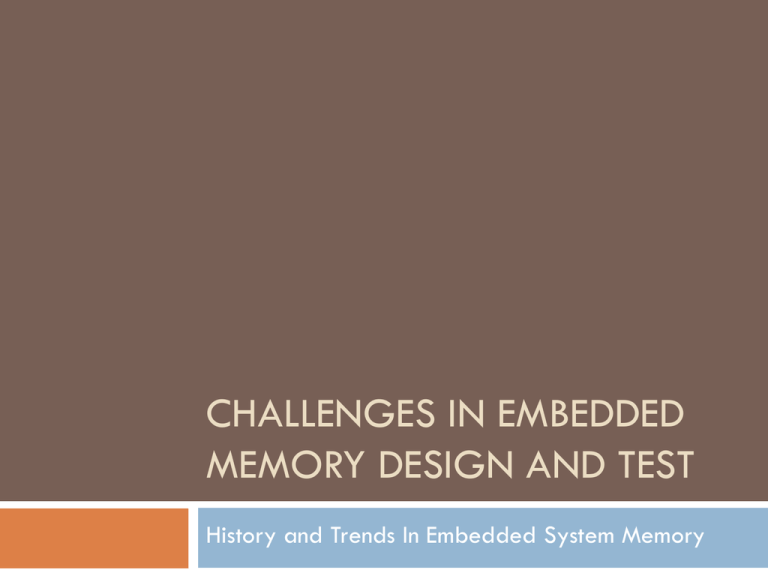
CHALLENGES IN EMBEDDED MEMORY DESIGN AND TEST History and Trends In Embedded System Memory Ideal Memory: Yesterday, Today And Tomorrow 1980 – 1990: The Stand-Alone Chip Three Main Types: SRAM DRAM Flash EEPROMs 1980-1990: The Stand-Alone Chip SRAM – The “S” is for “Static” 6T variety used in handheld systems due to: Low standby power Wide noise margin Ease of use 4T variety typically used for cache, especially for systems using mostly DRAM 1980-1990: The Stand-Alone Chip DRAM – The “D” is for “Dynamic” Must be refreshed periodically because the bits are stored with a capacitor, which leaks current Small cell size and high density made them ideal for larger memory systems. However, slower performance typically required the use of an SRAM cache Higher power consumption due to the need for refreshing, not suitable for handheld embedded systems. 1990-2000: Memory Integrated With Logic From 1990-2000, logic began to be integrated onto memory chips Sub-micron processes increased logic speed, requiring faster memories Also provided room for logic on the memory chip, allowing them to be synchronous Refresh circuitry for DRAMs now located on chip, allowed them to operate in an SRAM socket (PSRAM, “P” stands for “Pseudo”) 2000-2005: Scaled Embedded Memory Era of true embedded memory begins 100’s of millions of gates on a chip allows for a large portion of chips to contain memory that are functionally not a memory Embedded memory has different characteristics than standalone memory: Wide on-chip buses + parallelism High-speed operation not as important Commercial IP becomes equivalent of a memory standard The Product Perspective: Trends in SoC Design Memory content in SoC increasing dramatically from year to year. Memory either organized as large chunks of “hand optimized” blocks or smaller memories generated by compilers. Re-used logic and memory blocks exceed number of newly designed functions Why? Designs are stable faster allowing device manufacturers to meet a faster market window Product Perspective: Trends in SoC Design Advantages and Challenges To Embed Memories Why embed all this memory? If tailored properly you can achieve: Improved performance Lower power consumption On-demand memory activation / refined stand-by modes Higher bandwidth Package cost reduction and overall cost reduction Generalized form factor / board space advantages Advantages and Challenges To Embed Memories BUT: Drawbacks vs. using multiple chips Increased development complexity Memories need to be area optimized Need new design methodologies Need new testing methodologies Higher mask cost Higher effort to ramp one complex product Decreased flexibility and extendibility Implementation of Embedded Memory Devices: A Case Study Need to develop a communication device with the following requirements: Doubled Functionality 30% Performance Gain Compared To Multi-Device Solution Power must be optimized so that the device still fits into its former package Implementation of Embedded Memory Devices: Case Study Only solution was to embed all memory: Multi-chip failed: Off-chip driver for the larger memories absorbed 30% of power budget alone Need a customized floor plan where logic placement was optimized with respect to memory location. I.E. More than just sticking a big blob of SRAM on the chip somewhere Implementation of Embedded Memory Devices: Case Study Embedded Memory Test and Repair: Trends and Challenges Today’s SoCs have moved from being logicdominant to memory dominant More memory needed for today’s memory hungry applications Aggressive design of embedded memories leads to greater manufacturing and field reliability problems than any other part of the chip Overall yield thus relies heavily on the memory yield, significantly affecting cost Embedded Memory Test and Repair: Trends and Challenges Yield can be improved by offering redundancy in memories Requires determining the adequate type and amount from memory design techniques and failure history Further, need ability to detect where defects occur and knowledge of how to then incorporate redundant elements Test and Repair Power-Up Soft Repair Manufacturing Cost Traditional approach of Test-and-Repair requires extensive equipment and can contribute as much as 40% of the overall manufacturing cost of a chip Need to keep these costs down especially for highvolume consumer electronics or anything that is particularly cost-sensitive. Time-To-Volume Time-To-Volume is the time it takes a design to become sufficiently mature such that it can be manufactured in high volume at lower cost Dependent upon two factors: Initial SoC design time Re-use of proven IP cores Production Yield ramp-up time optimization: detect, analyze and correct problems Time-To-Volume Time-to-market pressure may require a shortened ramp-up period Can minimize TTV if yield optimization starts before ramp-up period Memory IP cores need to be tested in silicon and optimized beforehand to improve yield once incorporated into an SoC: “Silicon-Proven IP” Memory IP should already include all necessary diagnosis and failure analysis functions which can then be used during ramp-up Memory repair functions need to be designed together with the system as a whole to simplify the SoC ramp-up. Questions


